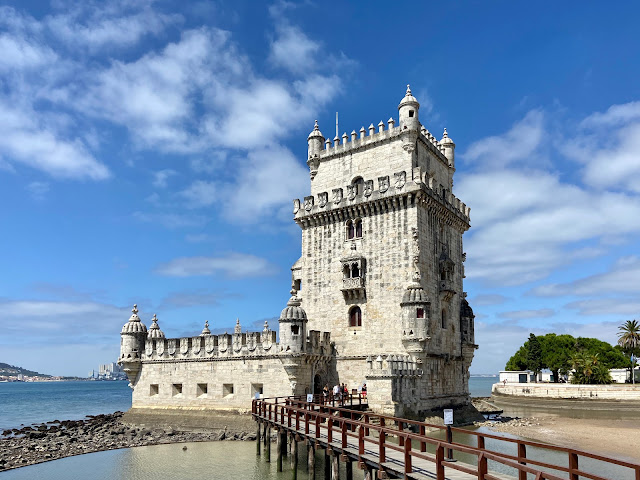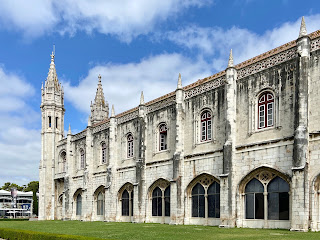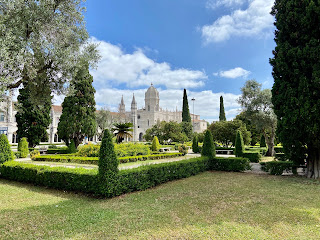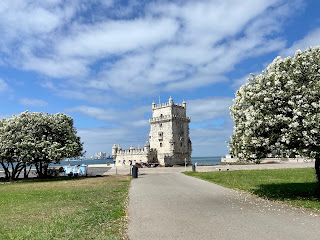What makes a tourist attraction? We are headed out to Belém, the western part of Lisbon, and I am rolling the question over in my head. We have been to Belém before, to see the Igreja and the Claustro do Mosteiro, but we did not see the outdoor sites as we ran out of time. The Torre de Belém is the tower from the old fort, the Castelo de São Vicente de Belém, and dates from the early 1500's. The other tower on today's agenda is the Padrão dos Descobrimentos (Monument of the Discoverers), dates from the late 1950's, though it is a reconstruction of the tower from the 1940 World Exposition.
These are two of Lisbon's most visited tourist attractions and usually involves a long queue, and they segment a piece of Lisbon's well-travelled riverfront. We hope the pandemic is going to make these famously congested towers easier to enjoy. Our transport today is a bus, Carris Autocarro 727. We have gotten used to traversing the city by Metro Lisboa, but Belém is not on the Metro, and requires an additional tram (and an additional fare). The bus may take just as long, but dings our passes only once.
Though the ride is over an hour, the time goes quickly, as we can watch the city move by (unlike the Metro), and choose new places to explore in the future. In particular, we pass the Casa Museu Amália Rodrigues, on the Rua de São Bento. The Casa Museu seems interesting enough (Amália is the Queen of Fado), but the street is a beauty, with well-scaled blocks trimmed with iron balconies. The Carris jogs around the Assembleia da República and then down the tree-lined Avenida Dom Carlos I, which looks like a great place to walk and shop.
The Carris puts us down at the east end of the Igreja de Santa Maria de Belém, and we walk westward along the wide and empty Praça do Império. This area is usually filled with tour buses, tuk-tuks, and people, but there is absolutely nothing and no one here. We are free to linger and take photos without interruption.
So many lonely attendants.
The old monastery is broken up into a series of tourist attractions: The Igreja and Mosteiro is on the eastern end, in the middle is the Museu Nacional de Arqueologia, at the western end is the Museu da Marinha (Martitime Museum), and attached to that (for some reason) is the Planetário Calouste Gulbenkian. Facing the Rio Tejo is the Jardim da Praça do Império, a large formal garden with wonderful stone mosaics (armillary spheres), and an impressive fountain (which is off today).
To cross under the Avenida da Brasila and the train tracks, and reach the river, there is a pedestrian under-pass. This takes us to the Rosa dos Ventos (Compass Rose), and an enormous stone mosaic plaza in front of the Padrão. We'll explore this on the way back.
The walk along the Tejo, from the Padrão to the Torre, takes us past the Museu de Arte Popular (Folk Art) and the Farol de Belém (Lighthouse) – places that seem like they should be interesting, but the Arte Popular is anything but, and the Farol is a ruin, fenced off with cheap-looking temporary barricades.
This area was developed for the World Expo in 1940, and it feels forsaken, though it might be the pandemic at work. But it's a quick walk to the Jardim da Torre de Belém, and the flowering trees there properly frame the old fort.
The upper and lower levels of the Torre are closed during the pandemic, but entry is half-price. It's a solid chunk of a thing, with Templar-cross shields adorning the battlements, and ball-finials atop each scallop-domed turret. It's simultaneously brutal and dainty. A U-shaped hall wraps an inner courtyard, with batteries facing out between the arched vaults. Heavy grated openings allows views down into the prison and up to the main level.
In a sense, the fort sets up like an old wooden battleship, with the big guns below decks. I suppose they prettied-up their ships, too, but it's hard to imagine all these stone carvings taking fire from enemy ships attempting to cruise the Tejo.
The courtyard is not grand in scale, but allows good light into the gun deck. Our view is drawn upward, to the gargoyles and the spiraling caps on the buttresses. The parapet is an open quatrefoil with more, embedded Templar crosses.
We arrive on the main level from the stair at the base of the tower block. The views out are between the crenelations, as the outer-wall is just high enough to give cover and meet the horizon. Standing watch at the front is a madonna and child inside a richly ornamented booth.
The tower rises another four stories, with a wide, columned, stone loggia commanding the scene; I imagine officers barking orders down to the artillery.
Inside the turrets are stone benches below each shuttered opening. There is room for soldiers to stand next to others seated, with small triangular openings at the floor all around – perhaps for ventilation as well as drainage. There are also well-located, block-sized openings just where a gunner on a knee might might be able to shoot at enemy combatants who have reached shore or trying to cross the drawbridge.
The winch used to raise the drawbridges is there, with some interesting blocks in the nearby floor, one large block parallel to the winch, and four smaller round blocks in a diamond pattern. Also fascinating are the various shapes in the courtyard parapet cap, with a tongue and leaf motif all along the rail.
We are able to stay a good long time at the Torre, no more than about a dozen other visitors join us. We descend the stairs just as a large family arrives. At midday, there is more activity in the Jardim and along the Tejo, but it's never crowded. Walking toward the Padrão, the sun behind the monument, the sailing ship silhouette is striking. Suitably, the light standards are in the form of armillary spheres.
On the starboard prow, the group of discoverers is anchored by Filipa de Lencastre, queen and mother of Henry the Navigator. In the center is the poet Luís de Camões, hold, one assumes, a poem (Lusíadas) on a scroll. Circling aft, we see that the thin mast-like profile is, in fact, a sword – padrão translates to pattern, but refers to the marker post, cross, or sword. I picture some great explorer stabbing a sword into a distant shore to claim it for his homeland. Though a lyrical vision (mast-cross-sword), it's probably not the best image for a colonial power in this statue-busting era of Black Lives Matter – pointedly, as the blade hangs over the door.
On the port side, the discoverers are raising a padrão, as they move forward toward Infante Dom Henrique, Henry the Navigator, holding a caravel. He plays the Kate Winslet part in this scene, and everyone else is Leo.
Inside, below decks, there is a small exhibition on the history of the monument, the Expo, and the development of the neighborhood. Up on top, there is a thin, long viewing platform, with sensational vistas in all directions, but a truly phenomenal view down to the Rosa dos Ventos; we can see the whole world.
Before we leave, we inspect the ventos (winds) in the stone mosaic up close, all the important dates and journeys are documented on the mapa mundial in the center.
There are certainly wonderful sites to see in Lisbon, though the riverfront in Belém lacks some organization and curation. I keep trying to assemble a story about discovery from the pieces, but it's hard to hold it together. It's an odd collection of spare parts – a church and monastery, archeology, a planetarium, formal gardens, towers, folk art, a lighthouse, and vacant cafes looking out over neglected marinas. Perhaps when things open up again, we'll return and dig a little deeper. Perhaps a guide would help, when there are guides again.
It was strange to see the Castelo de São Jorge deprived of tourists. Even then, without the throngs, it is still a castelo; Belém seems aimless without them. It's a place that's waiting.
In the past thirty days, the US case total has increased by more than a million. Just as disturbing, the seven day average for deaths per day is starting to increase as well.
cases: 12,155,602 global • 3,158,932 USA • 44,859 Portugal
deaths: 551,192 global • 134,862 USA • 1,631 Portugal

















































No comments:
Post a Comment